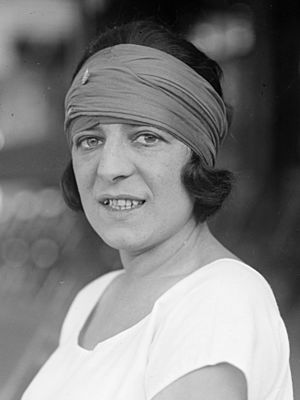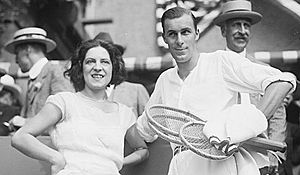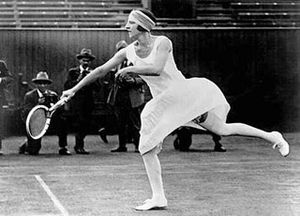Suzanne Lenglen facts for kids
 |
||||||||||||||
| Full name | Suzanne Rachel Flore Lenglen | |||||||||||||
|---|---|---|---|---|---|---|---|---|---|---|---|---|---|---|
| Country (sports) | ||||||||||||||
| Born | 24 May 1899 Paris, France |
|||||||||||||
| Died | 4 July 1938 (aged 39) Paris, France |
|||||||||||||
| Int. Tennis HoF | 1978 (member page) | |||||||||||||
| Singles | ||||||||||||||
| Career record | 341–7 (97.99%) | |||||||||||||
| Career titles | 81 | |||||||||||||
| Highest ranking | No. 1 (1919, A. Wallis Myers) | |||||||||||||
| Grand Slam singles results | ||||||||||||||
| French Open | W (1925, 1926) | |||||||||||||
| Wimbledon | W (1919, 1920, 1921, 1922, 1923, 1925) | |||||||||||||
| US Open | 2R (1921) | |||||||||||||
| Other tournaments | ||||||||||||||
| WHCC | W (1914, 1921, 1922, 1923) | |||||||||||||
| Doubles | ||||||||||||||
| Grand Slam doubles results | ||||||||||||||
| French Open | W (1925, 1926) | |||||||||||||
| Wimbledon | W (1919, 1920, 1921, 1922, 1923, 1925) | |||||||||||||
| Grand Slam mixed doubles results | ||||||||||||||
| French Open | W (1925, 1926) | |||||||||||||
| Wimbledon | W (1920, 1922, 1925) | |||||||||||||
|
Medal record
|
||||||||||||||
Suzanne Rachel Flore Lenglen (born May 24, 1899 – died July 4, 1938) was a famous French tennis player. She won 31 major tennis titles between 1914 and 1926. Suzanne was known for her exciting playing style and became the first female tennis celebrity. The French press even called her La Divine, which means "the Goddess."
Suzanne Lenglen was one of the first international female sports stars. She had an amazing record of 241 titles and only 7 losses in her career. She also had a winning streak of 181 matches in a row. Many people believe she was one of the greatest female tennis players ever.
Contents
Early Life and First Wins
Suzanne Lenglen was born in Paris, France. As a child, she often had health problems, including asthma. Her father, Charles Lenglen, owned a carriage company. He wanted Suzanne to become stronger, so he encouraged her to play tennis.
Suzanne first tried tennis in 1910 at her family's home. She enjoyed the game, and her father decided to train her. Just four years later, in 1914, Suzanne played in the final of the French Championships. She was only 14 years old. She lost that match but later that year, she won the World Hard Court Championships. This made her the youngest person to win a major tennis championship, a record she still holds.
World War I started soon after, which stopped most tennis competitions in Europe. Suzanne's rising career was put on hold for five years.
Becoming a Tennis Star
Tennis tournaments started again after the war. In 1919, Suzanne Lenglen played at Wimbledon for the first time. This was her first time playing on a grass court. She faced Dorothea Douglass Chambers, who had won Wimbledon seven times.
Their final match was very exciting. About 8,000 people watched, including King George V and Queen Mary. Suzanne won the match 10–8, 4–6, 9–7. She saved two match points, showing her incredible skill.
Suzanne also became famous for her style. At Wimbledon, she wore a dress that showed her forearms and was shorter than other players' dresses. This was very daring for the time.
Olympic Success
At the 1920 Summer Olympics in Antwerp, Belgium, Suzanne was amazing. She won the gold medal in women's singles, losing only four games in total. She also won another gold medal in mixed doubles with her partner, Max Décugis. She won a bronze medal in women's doubles as well.
From 1919 to 1925, Suzanne won the Wimbledon singles championship every year. The only year she didn't win was 1924, when she had to withdraw due to illness. She was the last French woman to win the Wimbledon ladies singles title until Amélie Mauresmo in 2006.
Suzanne also won the French Championships Singles title six times between 1920 and 1926. She won the Doubles title five times and three World Hard Court Championships. In 1922, she even starred in a short film called Tennis and How to Play It.
Challenging American Debut
In 1921, Suzanne Lenglen traveled to the United States. She planned to play exhibition matches to help raise money for France after World War I. She arrived in New York City feeling unwell after a difficult sea trip.
Tournament officials had entered her into the US Championships without her knowing. Even though she was sick with whooping cough, she agreed to play. In her first match, she faced Molla Bjurstedt Mallory, the US champion. Suzanne lost the first set and had to stop playing in the second set because she was coughing and crying.
The crowd booed her, and the American newspapers criticized her. Suzanne was very upset and returned home. Once she was healthy, she wanted to prove herself. The next year, at Wimbledon, she played Mallory again. Suzanne won the match in only 26 minutes, 6–2, 6–0. It was one of the fastest major tournament matches ever.
Final Amateur Year

In 1926, Suzanne Lenglen played her last year as an amateur player. She had a very famous match against Helen Wills. Helen Wills was a young American player who would later become a tennis legend.
Their match was a huge event. People paid very high prices for tickets, and crowds even watched from nearby rooftops. Suzanne won the match 6–3, 8–6. It was a very close game, and Suzanne was under a lot of pressure.
Later that year, Suzanne was playing at Wimbledon. She accidentally kept Queen Mary waiting for her match. Suzanne was told her match would start later, and she fainted when she learned of her mistake. This was seen as an insult to the Queen. Suzanne then withdrew from the tournament. This was her last time playing at Wimbledon.
Professional Career
Suzanne Lenglen was the first major female tennis star to become a professional player. An American businessman named Charles C. Pyle paid her $50,000 to tour the United States. She played a series of matches against Mary K. Browne, a former US champion.
This tour was special because the women's match was the main event. Suzanne won all 38 matches against Browne. After the tour, she was very tired and decided to retire from competitive tennis.
Suzanne then opened a tennis school in Paris with her partner, Jean Tillier. The school grew and became a training center for the French tennis federation. She also wrote several books about tennis.
Many people criticized Suzanne for becoming a professional player. The All England Club at Wimbledon even took away her honorary membership. But Suzanne explained her decision. She said that amateur rules meant only wealthy people could play tennis. She believed that professional tennis would allow more talented players to compete, no matter their background. She felt she had earned a lot of money for tennis as an amateur but had not earned much for herself.
Later Life and Legacy
In June 1938, Suzanne Lenglen was diagnosed with leukemia. She became blind three weeks later. She died on July 4, 1938, from pernicious anemia. She was buried in Saint-Ouen, near Paris.
Impact on Tennis
Before Suzanne Lenglen, not many fans were interested in women's tennis. But she changed that. People lined up to buy tickets to her matches. She was a passionate player who sometimes showed her emotions on court. She was also a brilliant player with amazing footwork, speed, and accurate shots. She dominated women's tennis for seven years.
Her excellent play and glamorous style made women's tennis, and women's sports in general, much more popular.
Honors and Recognition
In 1997, the second court at the Roland Garros Stadium, where the French Open is held, was renamed Court Suzanne Lenglen in her honor. The trophy given to the winner of the Women's Singles at the French Open is also called the Coupe Suzanne Lenglen.
In 2001, the French Tennis Federation started the Suzanne Lenglen Cup for women over 35. This event is now held in a different country each year.
Suzanne Lenglen was added to the International Tennis Hall of Fame in 1978. Many people still consider her one of the best tennis players in history. Wimbledon, for example, ranks her among their top five greatest champions.
In 2016 and 2017, Google honored Suzanne with a Google Doodle on her birthday and for International Women's Day.
Amazing Achievements
Suzanne Lenglen was ranked as the world's No. 1 player every year from 1921 to 1926.
During her career, she won:
- 81 singles titles, with 9 of them won without losing a single game.
- 73 doubles titles.
- 11 mixed doubles titles.
She won the Wimbledon singles, women's doubles, and mixed doubles championships all in the same year three times (1920, 1922, and 1925).
The World Hard Court Championships (WHCC) were the official clay court world championships. They were open to players from all countries. Suzanne won 31 major championship titles in total, counting her wins at the WHCC.
Images for kids
-
Lenglen with Bill Tilden
See also
 In Spanish: Suzanne Lenglen para niños
In Spanish: Suzanne Lenglen para niños





